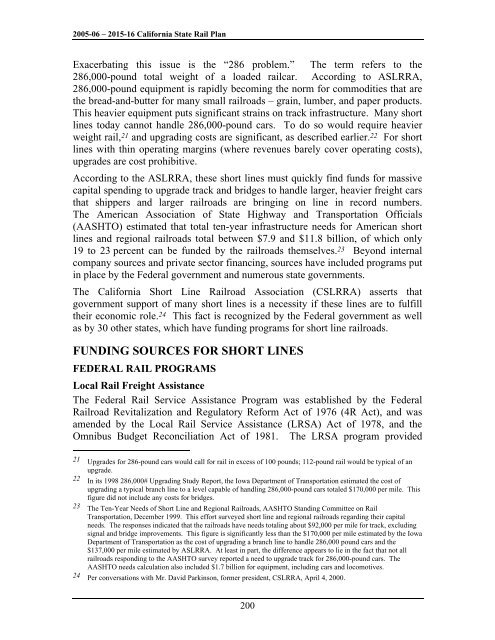California State Rail Plan 2005-06 to 2015-16
California State Rail Plan 2005-06 to 2015-16
California State Rail Plan 2005-06 to 2015-16
You also want an ePaper? Increase the reach of your titles
YUMPU automatically turns print PDFs into web optimized ePapers that Google loves.
<strong>2005</strong>-<strong>06</strong> – <strong>2015</strong>-<strong>16</strong> <strong>California</strong> <strong>State</strong> <strong>Rail</strong> <strong>Plan</strong><br />
Exacerbating this issue is the “286 problem.” The term refers <strong>to</strong> the<br />
286,000-pound <strong>to</strong>tal weight of a loaded railcar. According <strong>to</strong> ASLRRA,<br />
286,000-pound equipment is rapidly becoming the norm for commodities that are<br />
the bread-and-butter for many small railroads – grain, lumber, and paper products.<br />
This heavier equipment puts significant strains on track infrastructure. Many short<br />
lines <strong>to</strong>day cannot handle 286,000-pound cars. To do so would require heavier<br />
weight rail, 21 and upgrading costs are significant, as described earlier. 22 For short<br />
lines with thin operating margins (where revenues barely cover operating costs),<br />
upgrades are cost prohibitive.<br />
According <strong>to</strong> the ASLRRA, these short lines must quickly find funds for massive<br />
capital spending <strong>to</strong> upgrade track and bridges <strong>to</strong> handle larger, heavier freight cars<br />
that shippers and larger railroads are bringing on line in record numbers.<br />
The American Association of <strong>State</strong> Highway and Transportation Officials<br />
(AASHTO) estimated that <strong>to</strong>tal ten-year infrastructure needs for American short<br />
lines and regional railroads <strong>to</strong>tal between $7.9 and $11.8 billion, of which only<br />
19 <strong>to</strong> 23 percent can be funded by the railroads themselves. 23 Beyond internal<br />
company sources and private sec<strong>to</strong>r financing, sources have included programs put<br />
in place by the Federal government and numerous state governments.<br />
The <strong>California</strong> Short Line <strong>Rail</strong>road Association (CSLRRA) asserts that<br />
government support of many short lines is a necessity if these lines are <strong>to</strong> fulfill<br />
their economic role. 24 This fact is recognized by the Federal government as well<br />
as by 30 other states, which have funding programs for short line railroads.<br />
FUNDING SOURCES FOR SHORT LINES<br />
FEDERAL RAIL PROGRAMS<br />
Local <strong>Rail</strong> Freight Assistance<br />
The Federal <strong>Rail</strong> Service Assistance Program was established by the Federal<br />
<strong>Rail</strong>road Revitalization and Regula<strong>to</strong>ry Reform Act of 1976 (4R Act), and was<br />
amended by the Local <strong>Rail</strong> Service Assistance (LRSA) Act of 1978, and the<br />
Omnibus Budget Reconciliation Act of 1981. The LRSA program provided<br />
21 Upgrades for 286-pound cars would call for rail in excess of 100 pounds; 112-pound rail would be typical of an<br />
upgrade.<br />
22 In its 1998 286,000# Upgrading Study Report, the Iowa Department of Transportation estimated the cost of<br />
upgrading a typical branch line <strong>to</strong> a level capable of handling 286,000-pound cars <strong>to</strong>taled $170,000 per mile. This<br />
figure did not include any costs for bridges.<br />
23 The Ten-Year Needs of Short Line and Regional <strong>Rail</strong>roads, AASHTO Standing Committee on <strong>Rail</strong><br />
Transportation, December 1999. This effort surveyed short line and regional railroads regarding their capital<br />
needs. The responses indicated that the railroads have needs <strong>to</strong>taling about $92,000 per mile for track, excluding<br />
signal and bridge improvements. This figure is significantly less than the $170,000 per mile estimated by the Iowa<br />
Department of Transportation as the cost of upgrading a branch line <strong>to</strong> handle 286,000 pound cars and the<br />
$137,000 per mile estimated by ASLRRA. At least in part, the difference appears <strong>to</strong> lie in the fact that not all<br />
railroads responding <strong>to</strong> the AASHTO survey reported a need <strong>to</strong> upgrade track for 286,000-pound cars. The<br />
AASHTO needs calculation also included $1.7 billion for equipment, including cars and locomotives.<br />
24 Per conversations with Mr. David Parkinson, former president, CSLRRA, April 4, 2000.<br />
200













